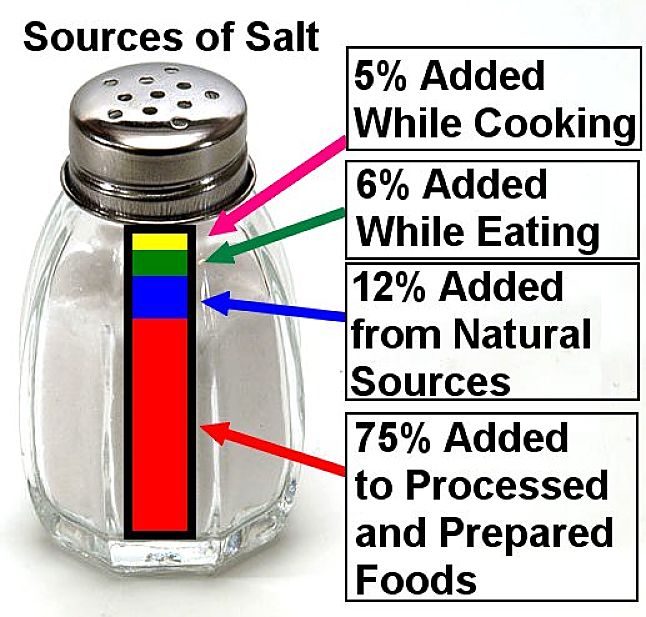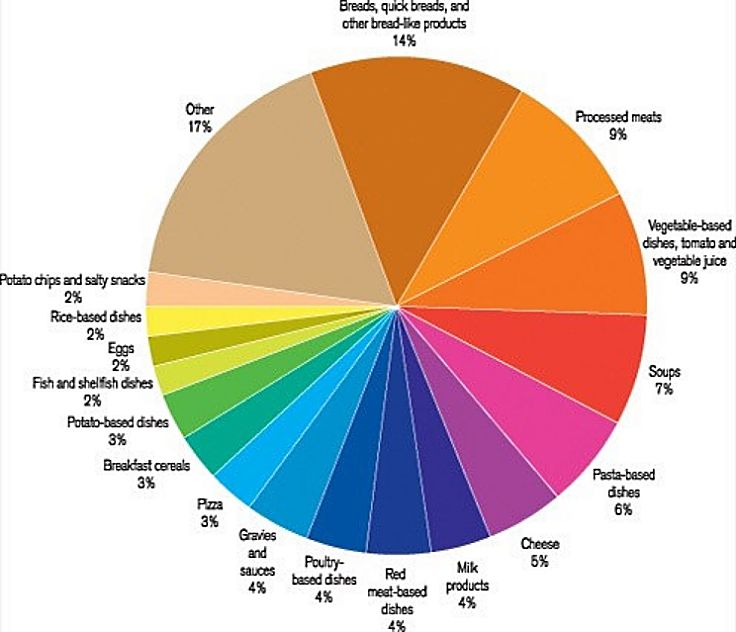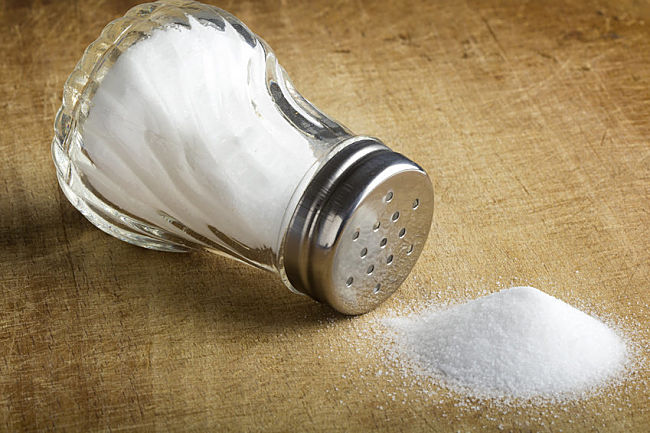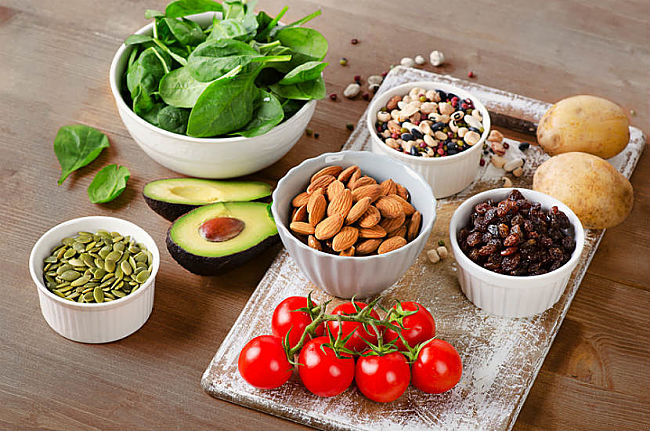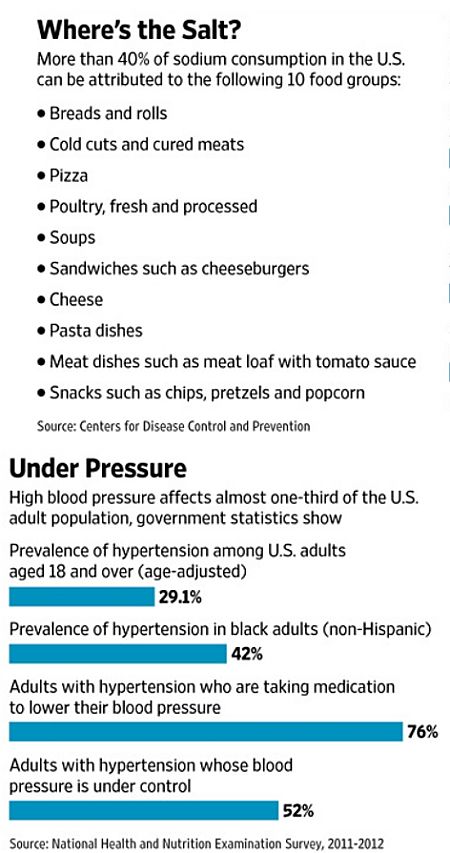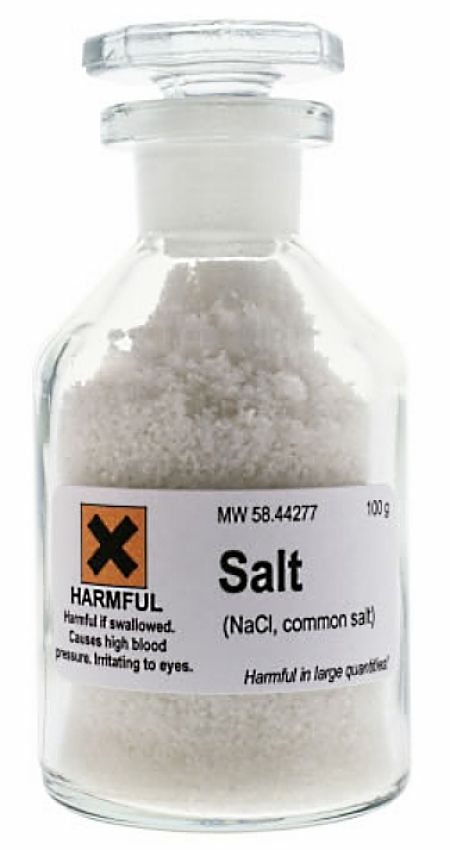Low Salt Diet Plan and Lists of Best and Worst Foods for Sodium
Health authorities throughout the world have urged people to lower their salt and sodium intake, to help reduce their blood pressure, and to lower the risk of stroke.
While the 'finger of blame' is pointed at fast foods, and the obvious salty snack foods such as chips, cookies, potato fries and sauces, very few regulations have been introduced to control the amount of salt added to processed foods.
It is left to the consumer to work out which foods they should and should not eat, and how much change in their diet is required to reduce sodium intake.
There is a lot of misinformation about salt, foods and diets which is making things worse.
For example, despite common beliefs, the major sources of salt in diets is not fast foods and obvious salt laden foods such as chips, but bread, processed meats, soups and sauces such as ketchup and pasta sauce.
It is common foods such as breads, ham, soups, tomato sauce, soy sauce and pasta sauce.
This article is designed to provide the answers to the key questions:
- Does a Low Salt Diet Really Lower Blood Pressure and Reduce the Risk of Stroke?
- Which foods have the highest and lowest amounts of salt (gm salt per 100g serving)?
- Can eating too little salt be dangerous?
- How much salt should people consume in their food to reduce the risks?
- Is it true that eating foods rich in potassium can counteract the effects of sodium on blood pressure?
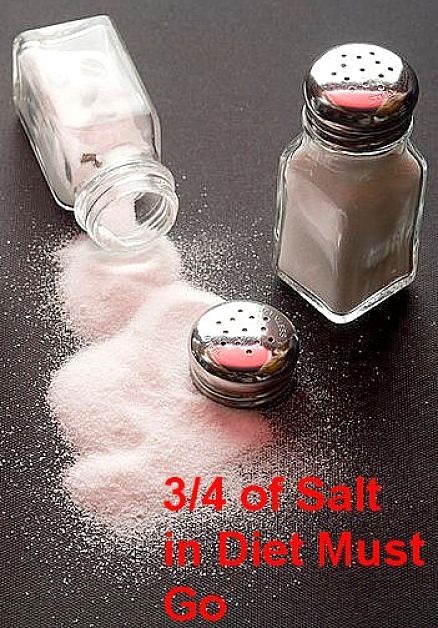
Sources of Salt in the Diet
Surprisingly, bread and rolls are the major source of salt in the American diet! Obviously salty snacks like pretzels and chips come in at No. 10 on the list of salt sources.
Top 10 Sources of Salt in American Diets and Their Contribution to Salt Loads
- White Bread and rolls, 7.4%
- Processed meats, 5.1%
- Pizza, 4.9%
- Fresh poultry, processed chicken and turkey meals, 4.5%
- Soups, 4.3%
- Sandwiches and burgers such cheeseburgers, 4%
- Cheese and dairy products, 3.8%
- Pasta dishes such as spaghetti with tomato and meat sauce, 3.3%
- Meat dishes with sauces and condiments, 3.2%
- Snacks, including chips, pretzels, bars, popcorn, 3.1%
The image shows similar results for the Canadian diet.
Most the salt consumed is not added by the consumer when either preparing food or adding salt at the table.
- 75% of all the salt consumed is added to the processed and prepared foods eaten
- 12% comes naturally from the natural food and ingredients
- 5% is added by consumers during cooking
- 6% is added from the shaker at the table.
These findings show that reducing salt intakes requires fundamental changes in diet, akin to the changes required to lose weight, rather than simply eliminating high salt snacks and fast foods.
Does Reducing Salt in the Diet Really Lower Blood Pressure and Reduce the Risk of Stroke?
A change in diet for 4 weeks or more produced significant lowering of blood pressure in both men and women and for people with normal and elevated blood pressures.
The study also showed that the greater the salt reduction, the greater the fall in blood pressure.
How much less salt should people consume in their food to reduce the risks?
Currently, various health organisations have recommended that people halve their average salt intake from an average of about 9-12 g/day to about 5-6 g/day.
The British study showed that this will be effective in lowering blood pressure and reducing the risks of stroke.
However, lowering salt intake by double this amount to 25% of current levels to just 3 g/day was likely to be much more effective and should be promoted as a health target.
Can Eating more Potassium in the diet counteract the effects of sodium on blood pressure?
Various major studies of the results and 22 previous research trials has shown that increased intake of potassium helped lower blood pressure and stroke.
Doing both simultaneously, that is increasing potassium while decreasing sodium, boosted the reduction in blood pressure, compared with changing just one of them.
This is because potassium and salt and potassium have opposite effects on the body.
Therefore, eating potassium-rich foods such as green leaf vegetables, avocados and bananas can offset the impact of sodium on the body. Most of these foods have very low sodium levels.
Foods Rich in Potassium include:
- Squash
- Black-eyed peas
- Prune juice
- Beans, Kidney
- Lentils
- Beans, baked
- Beans, Pinto
- Apricots, dried
- Fish
- Avocados
- Mushrooms
- Bananas
- Spinach
- Soybeans
- Squash, Winter
- Beans, Lima
- Potatoes
- Beans, white
- Beet Greens
Can Lowering Salt Intake too much be Harmful?
The simple answer to this is Yes! Various studies have produced conflicting outcomes and failed to show that lowing salt intake provided reduced levels of heart disease and lower risks of mortality.
How to Lower Salt Intake in the Diet
The general principle for lowering salt intake is:
Avoid processed foods and high salt in prepared meals. This includes fast foods but also white bread, processed meats and sauces.
Foods with High Salt Content that should be eaten in moderation include:
- Most snack foods, such as potato chips
- White bread and bread rolls.
- Packages and dehydrated foods, such as instant noodles, pasta or soups
- Most ‘fast’ foods, such as pizza
- Canned vegetables
- All Pre-packaged condiments and sauces including pasta sauces, soy sauce and most commercial tomato based sauces
- Processed meats, such as salami, sausages, frankfurters, hot dogs and luncheon meats
Tips to reduce salt intake in the diet are:
- Avoid adding salt to cooking and remove the salt shaker from the table
- Avoid all salty foods, including sauces and use soy sauce sparingly
- Replace processed foods with home cooked food made from natural ingredients
- Look for ‘salt free’ or ‘low salt’ versions of bought foods and ingredients
- Choose low-salt salt bread, sauces and breakfast cereals
- Replace salt in cooking by using spices and fresh herbs. Garlic, ginger, chili, oregano and basil reduce the need for salt
- Use juices such as lemon, grapefruit and lime juice to add a sour taste to meals
- Buy fresh vegetables instead of canned foods
- Make your own Pasta sauce using fresh tomatoes
- East takeaway and fast foods sparingly
List of Salt in Common Foods
The table below lists the amount of salt (mg) for a standard serving of 100g for 200 common foods.
The standard serving may be misleading in some respects because 100g is a lot sore sauces such as soy, ketchup and tomato paste.
Nevertheless it provides a standard for comparisons and should help to avoid high salt foods.
The foods are listed alphabetically.
The 20 foods with the highest salt density (mg/100g) serving are:
- Bouillon cubes
- Baking powder
- Beef, dried
- Bacon
- Olives, green
- Popcorn, salted with oil
- Cheese, Parmesan
- Beef, corned
- Pretzels
- Chili powder with salt
- Pickles, dill
- Sausage, Bologna
- Mustard
- Cheese, processed
- Most Cereals, commercial
- Crackers, saltines
- Pork, canned ham
- Sausage, Frankfurter
- Tomato ketchup
Salt Content (mg) of Common Foods for a Standard Serving of 100g
|
Food (100g)
|
Salt (mg)
|
Food (100g)
|
Salt (mg)
|
Food (100g)
|
Salt (mg)
|
|---|---|---|---|---|---|
|
Apple juice, bottled
|
1
|
Cocoa, dry
|
6
|
Peanut butter
|
607
|
|
Apple, raw unpeeled
|
1
|
Cocoa, processed
|
717
|
Peanuts, roasted
|
5
|
|
Applesauce, sweetened
|
2
|
Coconut, fresh
|
23
|
Peanuts, salted
|
418
|
|
Asparagus, canned
|
236
|
Coffee, beverage,
|
1
|
Pears
|
2
|
|
Asparagus, fresh
|
1
|
Coffee, instant, dry
|
72
|
Peas, cooked
|
2
|
|
Avocado
|
4
|
Collards, cooked
|
25
|
Peas, dried
|
40
|
|
Bacon, Canadian
|
2,500
|
Cookies , plain
|
365
|
Peas, green, canned
|
236
|
|
Bacon, cooked
|
1,021
|
Cookies, Fig bars
|
252
|
Pecans, shelled
|
0
|
|
Baking powder
|
11,000
|
Cookies, oatmeal
|
170
|
Peppers, green
|
13
|
|
Banana
|
1
|
Corn, sweet canned
|
236
|
Perch
|
79
|
|
Barly, pearled
|
3
|
Corn, sweet, cooked
|
8
|
Pickles, dill
|
1,428
|
|
Bean sprouts, cooked
|
4
|
Cowpeas, dry, cooked
|
8
|
Pickles, relish, sweet
|
712
|
|
Bean, canned
|
236
|
Crabmeat, canned
|
1,000
|
Pie
|
350
|
|
Beans, canned with pork and tomato sauce
|
463
|
Crackers, Graham
|
670
|
Pie crust, baked
|
617
|
|
Beans, Lima
|
1
|
Crackers, saltines
|
1,100
|
Pike, walleye
|
51
|
|
Beans, Lima canned
|
236
|
Cranberry juice or sauce
|
1
|
Pineapple, raw or canned
|
1
|
|
Beans, snap green, cooked
|
4
|
Cream
|
40
|
Pizza, cheese
|
702
|
|
Beans, white common, cooked
|
7
|
Cucumber
|
6
|
Plums
|
2
|
|
Beef hamburger
|
47
|
Dates
|
1
|
Popcorn, salted with oil
|
1,940
|
|
Beef hash, canned
|
540
|
Doughnuts
|
500
|
Pork
|
65
|
|
Beef pie or stew, commercial
|
400
|
Duck
|
74
|
Pork canned ham
|
1,100
|
|
Beef, corned
|
1,740
|
Egg, whole, raw
|
74
|
Pork, cured ham
|
930
|
|
Beef, dried
|
4,300
|
Eggplant, cooked
|
1
|
Potato chips
|
1,000
|
|
Beef, roasted broiled or stewed
|
60
|
Endive, curly
|
14
|
Potatoes, baked, boiled or french fried
|
5
|
|
Beets canned
|
236
|
Figs
|
2
|
Potatoes, mashed salted
|
331
|
|
Beets, cooked
|
43
|
Flounder
|
78
|
Pretzels
|
1,680
|
|
Beverage, fruit drink
|
0
|
Flour
|
2
|
Prunes
|
4
|
|
Beverages, beer
|
7
|
Fruit cocktail
|
5
|
Pumpkin, canned
|
2
|
|
Beverages, wine
|
5
|
Gelatin, dry
|
0
|
Radishes
|
18
|
|
Biscuits
|
630
|
Grapefruit, fresh, canned or juice
|
1
|
Raisins, dried
|
27
|
|
Blackberries
|
1
|
Grapes
|
3
|
Raspberries
|
1
|
|
Bluefish, cooked
|
104
|
Haddock, battered
|
177
|
Rhubarb
|
2
|
|
Bouillon cubes
|
24,000
|
Haddock, raw
|
61
|
Rice, cooked and salted
|
374
|
|
Bread
|
500
|
Heart, beef
|
86
|
Rice, dry
|
5
|
|
Broccoli, cooked
|
10
|
Herring
|
74
|
Rolls, bread or sweet
|
500
|
|
Brussel sprouts, cooked
|
10
|
Honey
|
5
|
Rutabagas
|
4
|
|
Butter, salted
|
826
|
Honeydew melon
|
12
|
Rye wafers
|
882
|
|
Butter, unsalted
|
10
|
Ice cream, vanilla
|
87
|
Salad dressing
|
1,000
|
|
Cabbage
|
20
|
Jams and preserves
|
12
|
Salmon, canned
|
387
|
|
Cakes
|
300
|
Jellies
|
17
|
Salmon, fresh
|
64
|
|
Candy, caramels, fudge
|
200
|
Kale, cooked
|
43
|
Sardines, canned
|
400
|
|
Candy, hard
|
30
|
Lamb, lean
|
70
|
Sauerkraut
|
747
|
|
Cantaloupe
|
12
|
Lard
|
0
|
Sausage, Bologna
|
1,300
|
|
Carrots
|
40
|
Lasagne
|
490
|
Sausage, Frankfurter
|
1,100
|
|
Carrots canned
|
236
|
Lemon, juice or fresh
|
1
|
Sausage, pork
|
958
|
|
Cashews, unsalted
|
15
|
Lettuce
|
9
|
Scallops,
|
265
|
|
Cauliflower
|
10
|
Lime, fresh or juice
|
1
|
Shrimp
|
150
|
|
Celery, raw
|
126
|
Liver, beef
|
184
|
Soup, canned
|
400
|
|
Cereal, Corn grits
|
1
|
Liver, pork
|
111
|
Spaghetti with meatballs, canned
|
488
|
|
Cereal, Cornmeal
|
1
|
Lobster
|
210
|
Spaghetti, dry
|
2
|
|
Cereal, Farina, dry
|
2
|
Macar0ni,cheese
|
543
|
Spinach, raw
|
71
|
|
Cereal, Oatmeal, cooked and salted
|
218
|
Macaroni, dry
|
2
|
Squash
|
1
|
|
Cereal, Oatmeal, dry
|
2
|
Margarine
|
987
|
Strawberries
|
1
|
|
Cereal, Rice flakes
|
987
|
Milk
|
50
|
Sugar, brown
|
300
|
|
Cereal, wheat flakes
|
1,000
|
Milk, buttermilk
|
130
|
Sugar, white
|
1
|
|
Cereal, wheat, puffed
|
4
|
Milk, dried
|
549
|
Sunflower seeds
|
30
|
|
Cereal, wheat, shredded
|
3
|
Milk, evaporated
|
106
|
Sweet potatoes
|
12
|
|
Cereals bran, wheat, crude
|
9
|
Molasses, dark
|
96
|
Syrup
|
68
|
|
Cereals, commercial
|
1,100
|
Molasses, light
|
15
|
Tapioca, dry
|
3
|
|
Cheese, cheddar
|
620
|
Muffins, plain
|
441
|
Tomato juice, canned
|
200
|
|
Cheese, cottage
|
406
|
Mushrooms
|
14
|
Tomato ketchup
|
1,042
|
|
Cheese, cream
|
296
|
Mushrooms, canned
|
400
|
Tomato, canned
|
130
|
|
Cheese, Mozzarella
|
373
|
Mustard greens
|
18
|
Tomato, fresh
|
3
|
|
Cheese, Parmesan
|
1,862
|
Mustard, prepared yellow
|
1,252
|
Tongue, beef
|
61
|
|
Cheese, processed
|
1,189
|
Nectarine
|
6
|
Tuna in oil
|
800
|
|
Cheese, Swiss
|
260
|
Noodles, dry
|
5
|
Turkey,
|
82
|
|
Cherries, Raw
|
2
|
Oil, corn
|
0
|
Turnips
|
34
|
|
Chicken pot pie, commercial
|
411
|
Okra,
|
2
|
Veal
|
80
|
|
Chicken, cooked, without skin
|
80
|
Olives, green
|
2,400
|
Vinegar
|
1
|
|
Chickpeas, dry
|
8
|
Onions, green
|
7
|
Waffles
|
475
|
|
Chicory
|
7
|
Orange , fresh
|
1
|
Walnuts
|
3
|
|
Chili con carne, canned with beans
|
531
|
Oysters, raw
|
73
|
Watermelon
|
1
|
|
Chili powder with seasonings
|
1,574
|
Pancakes
|
425
|
Wheat germ
|
827
|
|
Chocolate syrup
|
52
|
Papayas, raw
|
3
|
Yeast active
|
52
|
|
Chocolate, plain
|
4
|
Parsley
|
45
|
Yeast, compressed
|
16
|
|
Clams, hard, round
|
205
|
Parsnips, cooked
|
8
|
Yoghurt
|
46
|
|
Clams, raw soft
|
36
|
Peaches
|
2
|
Related Articles for Salt Impact and Uses
=> Wine Salt Marinade Recipes for Steak, Pork, Chicken with Herbs
=> Best Watermelon Margarita Recipes with Limes, Basil, Salt
=> Salt and Pepper Prawns, Shrimp, Squid, Calamari and Fish Recipes
=> Salt Pepper Squid Recipe - Best Ever Chinese Fried Squid Recipes
=> Are Muscle Cramps Caused by Salt Deficiency?
